Are you struggling with getting your horse to canter? Does it feel sloppy? All over the place? Tense? Scary? Does your horse just race faster and faster in the trot becoming more and more unbalanced? Or are you not really clear on how you are supposed to ask for the canter?
This is something I have struggled with in the past, not fully understanding the steps and aids to get a good canter. Through many lessons, instructors, horses, books and articles, I have learned how to effectively ask horses to canter.
By the end of this article I want to feel confident that you know how to ask a horse for the canter, and really understand the steps behind it.
So how do you effectively ask a horse to canter?
- Establish a balanced energetic trot.
- Make sure you’re relaxed & balanced in the sitting trot
- Flex the horse to the inside with a supporting outside rein.
- Prepare the horse for the canter transition with a preparatory outside half-halt.
- Think about slightly weighting & bringing forward your inside seat bone.
- At the same time apply inside leg at the girth & swish your outside leg 4-6 inches back.
- As the horse transitions into the canter, let your seat and arms follow.
- Do a series of half halts to re-balance the canter.
This is just a quick step by step look at how to correctly ask a horse to canter, but there is more to cover so you really understand these steps.
So keep reading and let’s go into better detail behind these steps to ask for the canter.
Steps To Asking Your Horse To Canter: Breaking It Down
Before we break down the steps for asking a horse to canter I just want you to be aware.
This method is not the only way to ask a horse to canter. This is the best method I have found and I like to use.
However if I were riding someone else’s horse or in a riding lesson, that horse may understand a different way of being asked to pick up the canter. In that situation, I would want to ask the horse to canter in the way that the horse is trained.
This being mentioned, most trained horses will understand to pick up the canter based on this method.
1. Establish A Balanced Energetic Trot
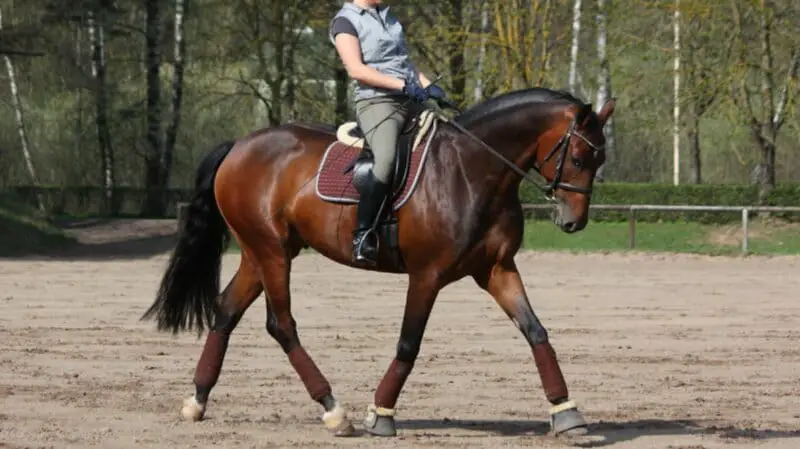
If your horse is unbalanced and rushing it will be difficult to pick up a nice canter.
You can push the horse forward enough that they will break into a canter (this is okay for horses just learning to canter because they don’t yet know the cues for cantering, but they know legs mean forward. Another topic for another post).
But in general rushing into the canter will cause it to be unbalanced, strung out and most likely tense.
Strung out is the opposite of a connected horse meaning that the horse is on the forehand and not properly using their back or hind end.
On the forehand is when the horse is carrying most of their weight on their front legs and seems to be almost going down a hill, while the back legs are traveling well out behind the horse, and the back is usually sunken down as well as tight and tense.
The hind end is the horse’s engine and in order to be balanced, energetic, connected and engaged the horse needs to lift his back and bring his legs under his body more to get that better balance, elasticity and spring.
Engaged is when the horse is using the power in their hind end and they are tracking under themselves.
Make sure the horse is in front of the leg and responsive to your aids at the walk and trot before you canter.
In front of the leg just means the horse is quick to respond to the leg aids to go forward and has good impulsion.
Impulsion is like the amount of spring and controlled power or energy the horse has.
The takeaway here is the better the trot you can create the better the canter will be.
2. Make sure you’re relaxed & balanced in the sitting trot.
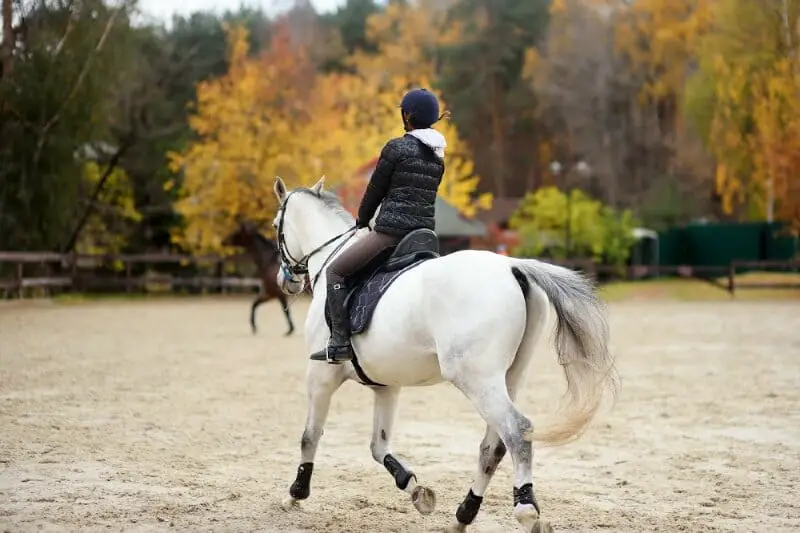
If you are unbalanced and wibble wobbling in the sitting trot that will make it much harder for the horse to be balanced.
What Do I Mean By Being Balanced?
- Your core will be tight to help stabilize your body.
- Your building blocks are stacked nicely on top of each other and will not topple as you allow your body to move with the horse.
- You are not leaning far forward or back or side to side. Your rib cage is centered over your hips and your hips are over your seat bones.
- You have equal weight throughout both seat bones and stirrups.
- Your shoulders are level.
- You should feel centered and balanced.
If You Are Tense And Not Relaxed
When you ask the horse to canter the horse will hear you saying “canter” with your aids but they will feel your body saying “”don’t canter” at the same time. This confuses the horses. Also keep in mind each horse may react differently.
If you hold tension in your seat (in other words your glute muscles)
When you are asking the horse to canter, the horse can feel the tension in his back which restricts the horse’s back movement and stifles the horse from transitioning freely and easily into the canter. If you are clenching your “seat” you are not only going to cause tension in the horses back but it will cause you to bounce. You will be essentially slamming down on the horse’s back which is not going to make for a happy willing horse.
If you hold tension in your arms (your arms are rigid, tight and not soft or following)
The horse can feel the tension and tightness through the bit into his mouth or on his face (if you are going bitless.) If your arms are not following when you go into the canter, (because the horse’s head will move up and down each stride in a rocking horse motion), the horse will feel an uncomfortable bop, jerk or tug every stride and the horse is most likely going to fall back into a trot if he even picks up the canter.
If you hold tension in your legs and grip (whether in your hips, thighs or calves)
The horse will feel the tension on their barrel. Because the horse swings their barrel side to side in each of the gaits, gripping the horse’s sides will restrict the barrel movement going into the canter. Most horses view squeezing your legs to mean forward. So if you continue to grip more often than not the horse will go faster and faster whether at trot or canter, trying to escape the pressure. Some horses may buck. Some horses won’t go forward if they feel a death grip and actually slow down or stop because they are wondering what the heck you’re doing.
So What Do I Mean By Relaxed?
- I’m not saying be so relaxed that you are a sack of potatoes ready to fall asleep and slide off the side of the horse.
- You are using muscles to balance yourself, hold your posture, move with the horse, and apply aids.
- Your core is engaged but your glutes are soft. If you’re tense and tight in your seat or glutes, this will cause you to bounce. There are times you may use your glute or seat muscles in a controlled way. When you drive the horse forward with your seat when you are slowing your horse down by slowing the movement of your seat when you are applying a half halt. These are a few ways you may use your glute muscles.
- Your shoulders are stable, open, and wide but pliable and your arms and hands are soft and following.
- Make sure there is no tension in your arms.
- Your head is balanced over your shoulders but your neck is free from tension.
- Your legs are in the correct position muscles are “toned” to hold position but not tense. Hips, knees and ankles need to be loose as they are shock absorbers for the horse’s movement.
The takeaway here. Evaluate your body for evenness on both sides and make sure your body parts are stacked correctly. Do a mental checklist head to toe becoming aware of any tension in your body and release it.
3. Flex Horse To The Inside With A Supporting Outside Rein
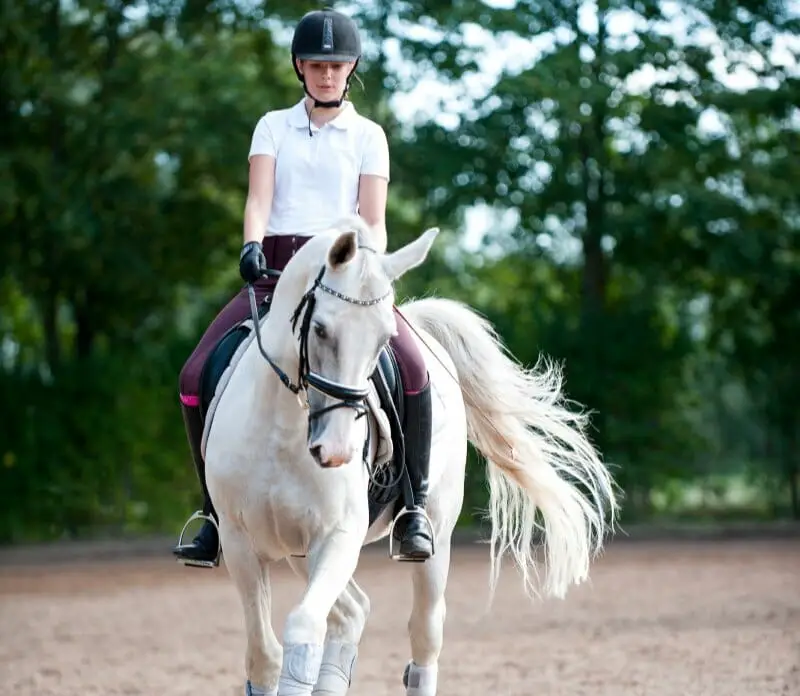
You want the horse to be slightly flexed to the inside and bending around your inside leg. However if you don’t throw away the outside rein the horse can become over bent opening up a lot of space for the outside shoulder, which means your horse will more than likely pick up the wrong lead.
The inside rein should be an asking and yielding rein. Going into the canter the inside rein should be soft.
The outside rein controls the amount of flexion in the horse’s neck and supports the outside shoulder so that the horse is not over bent with the shoulder popping to the outside.
If the horse is really struggling to pick up the correct canter lead, after several tries, work on getting the horse straighter with a slight flexion to the outside to open up the inside shoulder and make it easier for the horse to get the correct lead.
4. Prepare the horse for the canter transition with a preparatory outside half-halt.
Check out this awesome article by Christian Thiess originally written in 1986, explaining half halts. The Misunderstood Half Halt: The Alphabet of Riding.
Basically the article explains:
- How most riders are confused about how exactly to apply half halts.
- How the way most riders apply half halts hinder the horse.
- Why and when to use half halts.
- The different kinds of half halts.
- How to correctly apply half halts.
- What half halt is known to be called in other parts of the world.
The main purpose of using the outside half-halt as preparation for the canter transition is to alert the horse that there is going to be a new movement and to re-balance the horse off the forehand and onto the hind end more.
How To Apply Outside Half Halt:
- Inside rein is steady with no slack but is also elastic and the inside leg is against the horse’s side but passive.
- You need the right timing to apply the outside half halt at the sitting trot in order for it to be effective and not hinder your horse.
- You want to apply the outside half halt when the outside hind is coming up off the ground up and release the half halt right as the inside hind touches the ground. This gets the outside hind leg to engage more.
- To get the timing right if you aren’t able to feel this, when the inside shoulder is back just before it starts moving forward is when to apply the outside half halt and immediately release right before the shoulder starts to move back again.
- Almost simultaneously you are applying outside leg, seat and outside rein for the outside half halt.
- A preparatory half halt for a transition is stronger than regular half halts within the gait. This really gets the horses attention and helps the horse to come back onto the hind end more.
For more information on half halts and correct use, check out that article I mentioned. I am just learning these methods and it is making all the difference in my riding.
5. Bring Your Inside Seat Bone Forward & Slightly Weighted
Bringing your inside seat bone forward and slightly weighted indicates to the horse to pick up the inside lead.
But it also puts you in the correct position for your inside leg at the girth and outside leg behind the girth.
6. Apply Inside Leg At The Girth And At The Same Time Swish Outside Leg Back 4-6 Inches With A Squeeze And Release
The inside leg is telling the horse to go forward as well as helping the horse to keep from falling in.
The outside leg is telling the horse to pick up the correct canter lead and to strike off with the outside hind leg which is the first beat or footfall in the three-beat canter.
Three-Beat Canter
- Outside hind
- Inside hind & outside front
- Inside front
- Moment of suspension
- Repeat
Suspension
When all 4 of the horses feet come up off the ground.
7. Let Your Seat And Arms Follow As The Horse Transitions Into The Canter
The moment your horse starts to canter, relax your aids.
You want to stay stable from your belly button up but your pelvis should move and follow the motion. While moving your pelvis with the motion of the horse you may be able to feel your inside hip leading slightly and moving a little bit more than the outside hip.
Keep your legs positioned inside leg at the girth and outside leg slightly back to keep the bend in the canter.
Your arms should not be making exaggerated pumping motions but keeping a consistent elastic feel on the reins and following the movement of the horse’s head.
8. Do A Series Of Half Halts To Re-balance The Canter
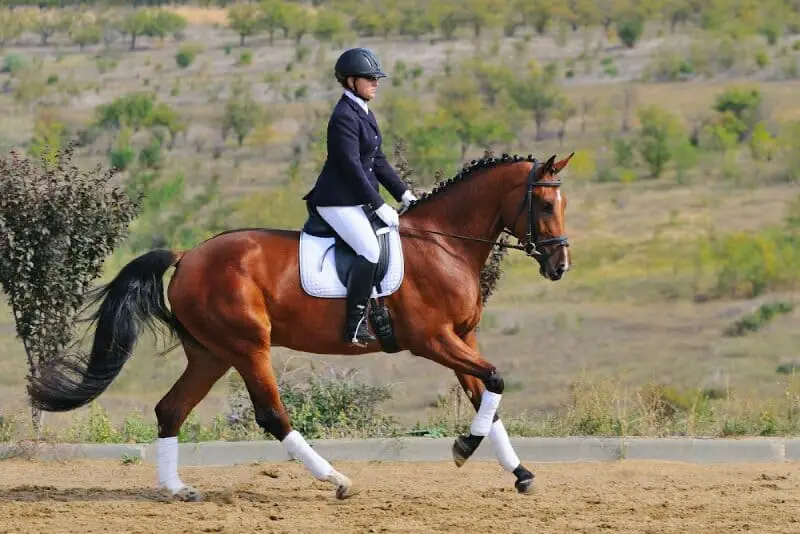
After a few strides of canter, once you have the following motion down, you are stable in your upper body and balanced, it’s time to re-balance your horse in the canter.
Apply a series of half halts to bring your horse back onto his haunches (the horse’s hind end) and lighter on the forehand for a more balanced better quality canter with more spring into the suspension.
You will want to apply half halts for every stride for several strides.
Notice how I said “half halts” every stride not “half halt” every stride. That’s because there are two half halts to give each stride. One for outside hind and one for inside hind.
Again I suggest you read the article on half halts by Christian Thiess.
How To Half Halt At The Canter
- The two half halts follow each other almost immediately. Starting a half halt with outside and then inside.
- The timing to apply the half halts needs to be right. Incorrect timing will hinder more than help the horse.
- The outside half halt begins when the outside hind comes up off the ground. This is when the horse starts to come down in the up and down rolling motion of the canter.
- As soon as the inside hind comes off the ground which is a split second after the outside hind, your outside half halt is released and inside half halt is applied.
- Release the inside half halt before the horse is in suspension.
- Repeat for several strides.
If You Are A Beginner Learning To Canter

If you are just learning to canter some of these steps may be too advanced for you. In order to apply these aids and be effective with the horse you need to have an independent seat.
An independent seat means that you can stay balanced, free of tension, move with the horse’s movement, and move your arms, legs and seat independently of each other. You have full control over your body while riding in motion with the horse.
As a beginner you need to work on developing your independent seat.
When you start to canter, the aids you use will be simpler.
A Beginner Asking A Horse To Canter May Be:
- Make sure reins are short enough that you can squeeze a rein and the horse can feel it but long enough that it doesn’t feel tight or like you are pulling back on the reins.
- Sit up straight and tall in the saddle and stay that way throughout the transition.
- Pick up a sitting trot on a 20 meter circle, because it will be easier to get the correct canter lead on a circle. Make sure the sitting trot has some energy but is not fast.
- Make sure you are relaxed and balanced before you ask for the canter.
- Before asking for the canter give a couple squeezes of your calves while at the same time a couple squeezes of the outside rein, to prepare the horse for canter.
- Squeeze inside leg at the girth and slide outside leg behind the girth with a quick squeeze release, at the same time say canter nice and clear.
- Relax your hands allowing the horse to canter and follow the motion with your hands and seat.
The voice command helps the horse understand what you are asking, since your aids may not be super clear to the horse while you are learning.
Tip: Lunge line exercises can be beneficial to improving and learning how to move in the canter and to develop your independent seat. You need a horse that is safe and well trained to the lunge line and you need a knowledgeable and experienced horse person or instructor to lunge you.
Points To Remember When Asking Horse To Canter
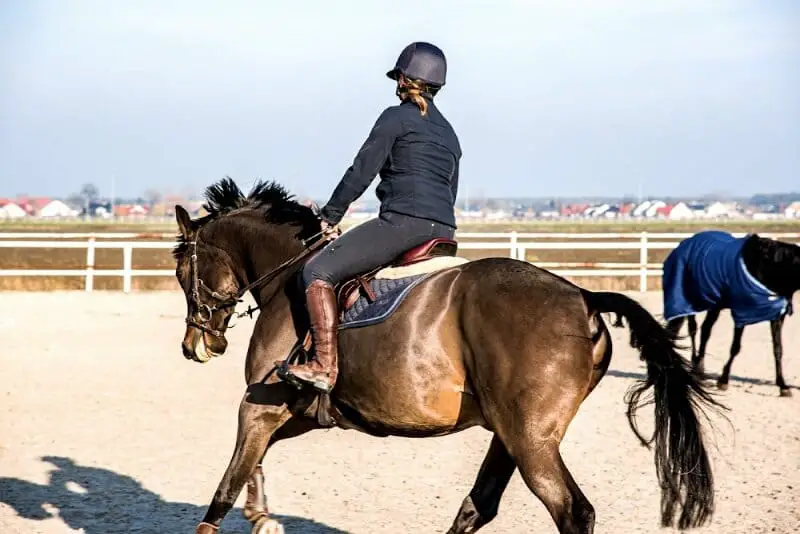
- Prepare… prepare… prepare and then some more. Get a good quality trot, make sure both you and the horse are balanced and have straightness and good energy.
- Support the outside shoulder in the transition, don’t drop the outside rein.
- Half halt right before asking for canter and after horse canters to rebalance.
- You want soft following hands and seat as you transition into the canter.
- Think about allowing the canter.
BONUS TIP 1: Quietly exhale through your canter transition, to help release the tension in your body as you ask for the canter.
BONUS TIP 2: Think about your horse lifting up toward you in the canter depart instead of just thinking of the horse going into a faster gait.
I hope this helps you understand more fully how to ask a horse to canter whether you are just learning or want to refine your canter aids.
Leave a comment if you need some further clarification on any parts and I will do my best to provide a helpful answer.
Find This Article? Helpful Check Out These!
- Improve Your Riding At Home With An Exercise Ball: 8 Yoga Ball Exercises For Horse Riders
- Different Kinds Of Horse Leases: Choosing What Kind Is Best For You
- How You Can Improve Your Riding Skills Without A Horse
- 9 Powerful Ways You Can Restore Your Confidence Riding Horses
- 10 Must Read Horse Books For Getting Started As An Equestrian
Cheers, Kacey

